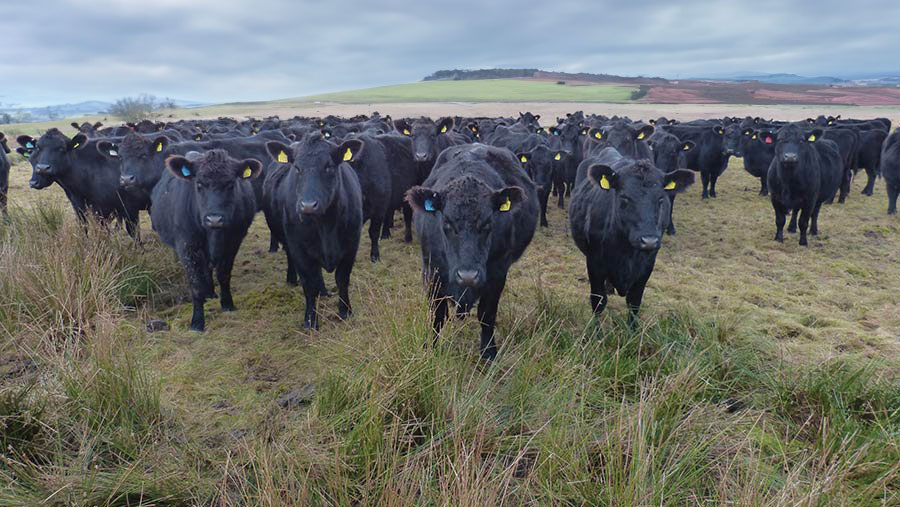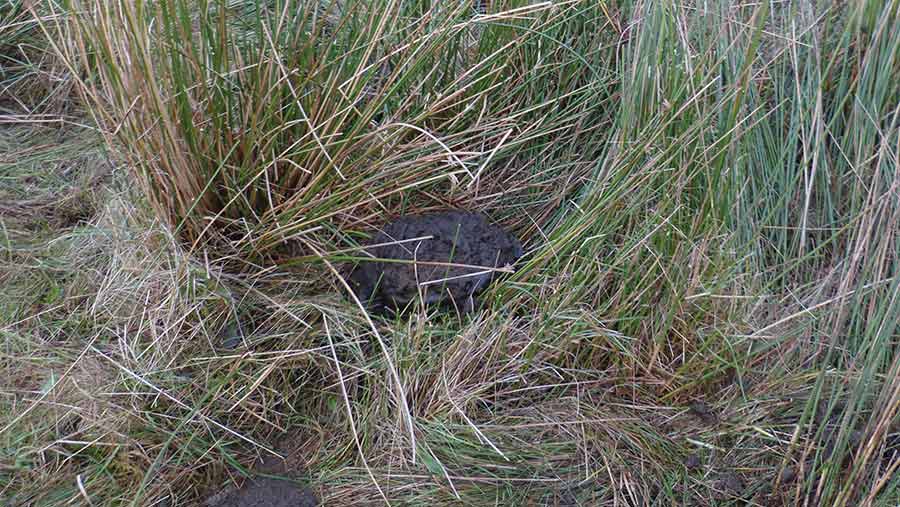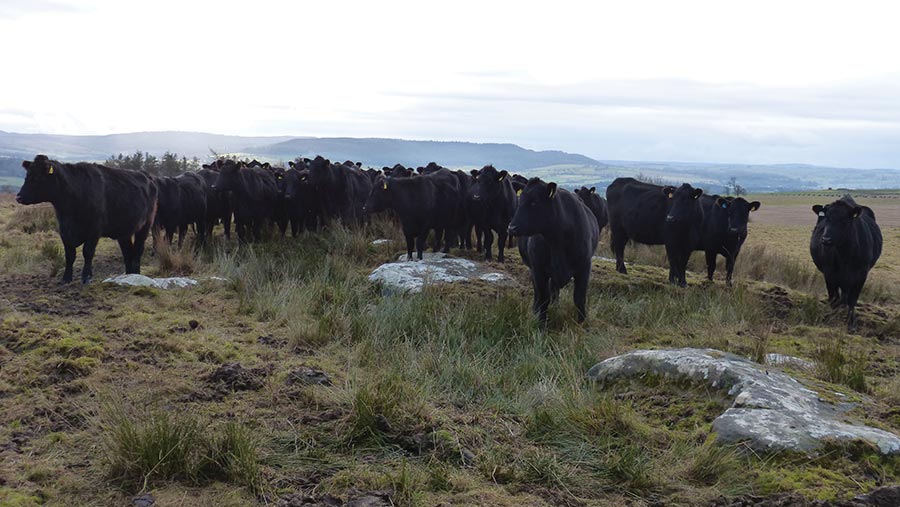How a suckler and sheep unit aims for 10% return after rent
 © MAG/Michael Priestley
© MAG/Michael Priestley A young Northumberland farmer is staying profit-focused on the family unit by aiming to generate enough cash to theoretically buy the farm.
Covering a commercial rent and 10% interest after all costs on the 485ha (1,198-acre) Broome Park Farm, just west of Alnwick, is the target of beef and sheep farmer George Burrell.
George’s vision crystallised after attending a Ranching for Profit course by Dallas Mount, of US business Ranch Management Consultants, in December 2023.
George had read about the course and attended the AHDB’s British version, called “Roots to resilience”.
See also: Video: Outwintering system hopes to beat £163 a cow savings
The three-day course gave George a grounding in analysing people, enterprises, margins and cost structure. The following three-year targets are among the aims for the farm:
- Increase stock numbers and hold (or reduce) labour requirement
- Pay a commercial rent every year
- After rent costs, make a 10% margin on capital employed (all labour, machinery, sheds, stock valuation and so on).
Farm facts: Broome Park
- 485ha rented from family trust
- Mix of ploughable land, rig and furrow and rocky hill ground (roughly one-third of each)
- 200 pedigree Aberdeen Angus cows
- Sold 46 bulls off farm last year
- About 10 Murray Greys and Herefords for experimental crossing
- 1,200 breeding ewes (Chevease, Lleyn and Aberfield-cross)
- 400-500 ewe lambs tupped
- 200 Innovis ram lambs on keep for neighbour
- Stock sold deadweight or store
Business experience
George is in his third year of farming full-time, having worked in Africa and New Zealand, and completed an agribusiness degree at Newcastle University.
He returned home in November 2019, farming one day a week while he worked in the farm office of a local estate for more than two years, learning about margins and systems.
Tenancy
The farming business is set up to pay rent to the partners of the family trust that hold the farm asset.
Rents are based on George’s experience working at the estate. “In terms of paying a rent and 10% interest on all other tenant’s capital, the business is close to achieving its aim,” he explains.
Trying to satisfy the requirements of “profit, people and place” as advised by the business course, George has adopted a three-pronged approach to help him work towards his targets.
1. Lower fixed costs
Roots to resilience principles
- Run economic accounts alongside tax accounts
- Fixed costs (land, labour and machinery) must be covered from the start
- Look at the biggest costs in your cashflow and address them first, rather than smaller, easier costs
- Items must give a return on investment – a tractor costing £100,000 must earn £20,000 (10% maintenance cost and 10% interest) to stand still as an investment each year. The same goes for a shed or a cow
- Aim for £400,000 of income per employee
- Minimise machines where possible. Because the farm outwinters and calves outside, a tractor is only needed to arrange bale pods in summer
Recent changes
- The difficult decision was made to make a member of staff redundant
- The farm went from two-and-a-half people across 313 livestock units to two-and-a-half labour units across 480 livestock units. George is salaried, working two days a week contract hedging and fencing
- Reduced cattle mobs from 14-16 to four mobs. Increased bulling groups from 30 head to 100 head
Three-year targets
- Keep expanding sheep flock, which has grown from 200 to 1,200 head already
- Spread the cost of two full-time labour units (with seasonal and part-time help) eventually across 200 cows and 2,000 ewes
- Reduce cow depreciation (incoming heifer value minus cull cow value divided by productive years on farm) from £65 a cow to £15 a cow by selling high-health, in-calf three- and four-year-old cows as breeders
- Cut depreciation from £28/ha to £20/ha by selling an 80hp tractor and a forklift (leaving one forklift and one tractor), reducing hours on all machines and letting out some farm buildings for storage/equine use

Subdivision with electric fencing has improved productivity, with rocky hill land now grazed in winter and summer © MAG/Michael Priestley
2. Increase gross margin
Roots to resilience principles
- Gross margins can be misleading. For example, when George first moved home, they were getting £880 a cow/calf finisher when selling steers for £1,400 a head, but the farm was understocked
- Increase gross margin through low-cost improvements in technical performance
- The timing of stock sales matters. Sell lambs as soon as possible after weaning and cull old cows in midsummer by weaning early
Recent changes
- Budgeted £21,000 for field subdivision – 50% has already been spent on carrying out the subdivision and buying new water points to attach to plastic troughs
- Rotational grazing is growing as much grass as fertiliser did. The farm is saving on 12t of 20:10:10 every year, only using fertiliser on fodder beet and wheat
- Larger mob sizes mean less subdivision to create 21-day rotations. Five reels of wire can contain 100 grazing cows for the summer and winter. Using three portable troughs instead of 10 fixed troughs
- Growing more grass has reduced silage demand and contractor costs. Now cutting 40ha (99 acres) instead of 48ha (119 acres), despite an increase in stocking rate
- Trace element boluses used – these are deemed essential for ewes and cattle
- Swards including red clover have increased from 180ha (445 acres) to 200ha (494 acres), hopefully allowing a quicker finish for lambs and steers
Three-year targets
- Improve silage quality to reduce barley (8t in 2023) and rapeseed meal (14t in 2023) buying
- Better fencing infrastructure will aid early (May) silage cutting to produce high-quality feed for steers and fattening heifers, rather than waiting for June/July
- Explore growing lucerne silage on lighter land to reduce bought-in feed for finishing steers
- Aim for 10-11% crude protein silage and at least 10MJ/kg metabolisable energy for growing and finishing youngstock
- Reduce winter costs by wintering weaned heifer calves outside on deferred grass and hay

© MAG/Michael Priestley
3. Increase overall turnover
Roots to resilience principles
- Turnover can be increased by either boosting the value or volume of what is sold. Any attempts to increase turnover must come after evaluating their effects on the cost base of the enterprise
- Being productive does not mean being profitable
Recent changes
- Years of hard culling on ease of fleshing has left a herd of 620kg cows, which can be stocked at a higher rate than 760kg cows were 10 years ago
- Increased productivity of a 62ha (153-acre) grassy and rocky hill – of which 15ha (37 acres) is heather – with electric fencing subdivision. Previously, the hill was grazed one-and-a-half times a year (winter only); now it is grazed two-and-a-half times a year and is used in winter and summer
Three-year targets
- 700-750kg of liveweight produced/ha, up from 530kg in 2023
- Could more ewes rearing more twins increase farm output if ewe lambs were contract-reared or grazed elsewhere?
- Consistently achieve ewes rearing 150% or more
- Increase sheep stocking density from 10 ewes a hectare to 14
The numbers
- 142 Cut-off point for cow height (cm) so cows hold condition through winter – 132-137cm is optimal
- 660 Extra cow grazing days the hill provides annually for wintering since it has been rotationally grazed
